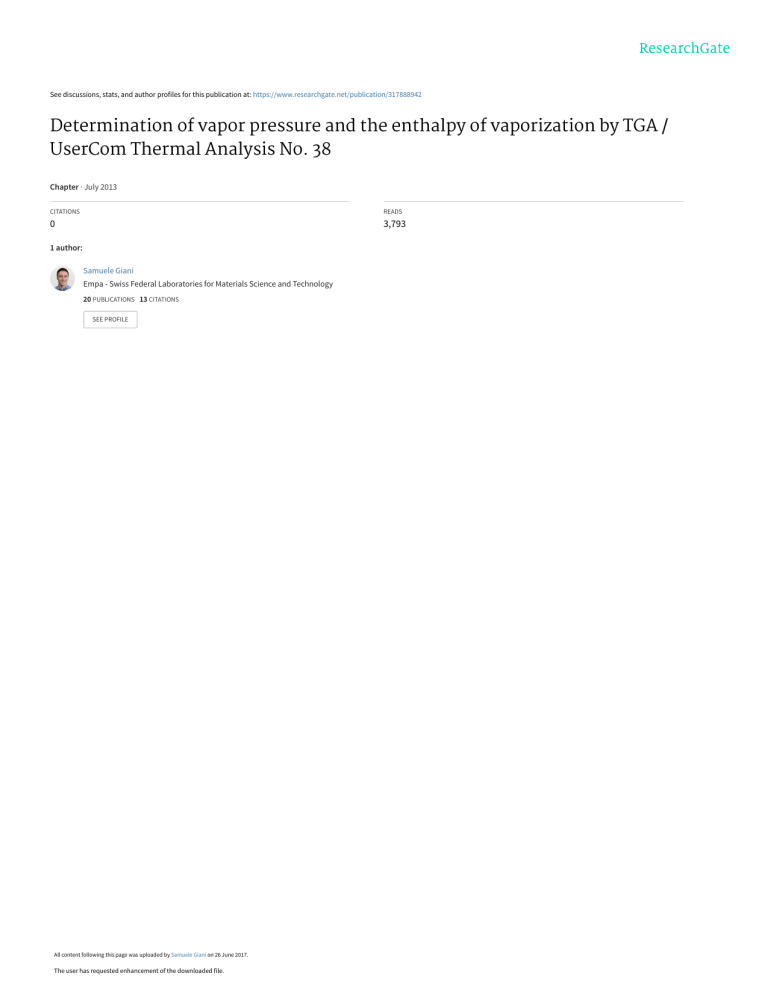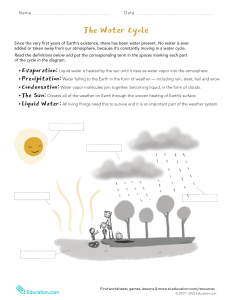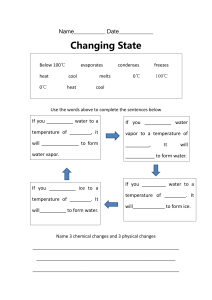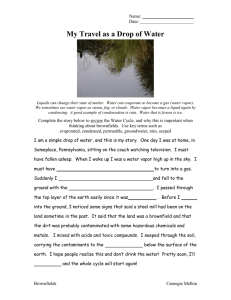
See discussions, stats, and author profiles for this publication at: https://www.researchgate.net/publication/317888942 Determination of vapor pressure and the enthalpy of vaporization by TGA / UserCom Thermal Analysis No. 38 Chapter · July 2013 CITATIONS READS 0 3,793 1 author: Samuele Giani Empa - Swiss Federal Laboratories for Materials Science and Technology 20 PUBLICATIONS 13 CITATIONS SEE PROFILE All content following this page was uploaded by Samuele Giani on 26 June 2017. The user has requested enhancement of the downloaded file. clear differences. The peak temperatures of the melting peaks differ by about 8 K. This means that Sample A ( mass about 50 ng ) consists of crystallites that are more stable and larger that melt at higher temperatures than Sample B ( mass about 80 ng ). The two melting peaks have different shapes but the degree of crystallinity is about the same. Conclusions Two samples of polypropylene produced by different processes were investigated by DSC and Flash DSC. The final products exhibited different mechanical properties. No significant differences were detected in the crystallization and melting behavior using conventional DSC. In contrast, Flash DSC measurements allowed the two materials to be clearly distinguished. Differences were observed in the crystallization behavior in cooling measurements and in the first heating runs of the original samples. References [1] [2] The new Flash DSC 1, UserCom 32, 6. J. E. K. Schawe, Practical aspects of the Flash DSC 1 : Sample preparation for measurements of polymers, UserCom 36, 17 – 24. Determination of vapor pressure and the enthalpy of vaporization by TGA Samuele Giani The vapor pressure of a chemical compound is a measure of its volatility : the higher the vapor pressure at a given temperature, the greater the probability that the substance is in the gaseous state rather than the condensed phase ( liquid or solid ). The vapor pressure of a substance increases with increasing temperature. The boiling point is reached when the vapor pressure is equal to the total pressure of the surroundings. Introduction Knowledge of this thermophysical property and the enthalpy of the corresponding phase transition are of fundamental importance for areas such as process control, storage of materials and stability. The data is used for establishing environmental guidelines and to define the maximum allowable limiting values and is also needed for preparing safety data sheets. There is a need for a simple method to determine the vapor pressure of substances for industrial applications as well as for basic research. The method should be routinely applicable, reliable, rapid and straightforward to perform. In this article, we will show that thermogravi- metric analysis ( TGA ) using a reference substance is a suitable technique. Theoretical background Several methods are available for determining the vapor pressure of substances. Some are based on techniques such as ebulliometry or gas saturation methods, others on static methods using a manometer ( e.g. HPDSC ). Another group of methods makes use of the so-called effusion technique. The effusion technique is based on the determination of mass loss. Devices such as the Knudsen cell and techniques derived from this have become of special interest. This is because their theoretical description takes into account effects a Figure 1. Schematic view of an effusion cell. The gas phase and condensed phase ( liquid or solid ) of a substance are in equilibrium. d p, T that depend on a particular experimental setup. These can be due to different geometrical factors or result from the necessity of not having to work in high METTLER TOLEDO UserCom 38 15 vacuum in contrast to the original Knudsen method. An effusion cell is shown schematically in Figure 1. Applications The design is an open system in which molecules leave the cell by passing through an effusion hole. In thermal equilibrium, mass loss occurs at a constant rate. An experimental setup like this can be realized with practically any conventional TGA. Thermogravimetric analysis ( TGA ) is based on the continuous measurement of the mass differences of a sample as a function of temperature and time. The method is therefore ideal for investigating processes such as vaporization or sublimation [1, 2]. In contrast to the method based on a Knudsen cell in high vacuum [3], the experimental setup can be parameterized at ambient conditions. This is done using a known reference substance and is based on the generalization of the Langmuir equation for free vaporization [4]. log(pT) = s · log 1 dm a dt +b T In this equation: a Figure 2. Typical temperature program ( Ts ) and the corresponding mass loss curve ( TGA ) of benzoic acid. The curves on the right show the rate of mass loss ( DTG ) in the different temperature segments. is the area of the effusion hole (1) dm dt pT T check the vapor pressure measurement for a known value of ∆H. is the rate of loss of mass (DTG, derivative TGA curve) at a given temperature Experimental details is the vapor pressure at the given temperature The crucible was the effusion cell. The mass loss was measured at different isothermal temperatures using the TGA. The parameters s ( slope ) and b ( y-axis intercept ) can be determined after linearization of equation ( 1 ) by measuring a chemical substance with a known vapor pressure curve. The two parameters s and b are then known and the vapor pressure of an unknown substance can be determined under identical experimental conditions. In the work described here, benzoic acid was chosen as the reference substance. The Clausius-Clapeyron equation of state ( 2 ) describes the relationship between the vapor pressure of a pure substance and the absolute temperature. 1n(p) = L – ∆H 1 R T (2) In this equation : ∆H is the change in enthalpy of the phase transition ( vaporization or sublimation ), L is a substance-dependent constant, and R is the universal gas constant. This equation can be used to determine the enthalpy of the phase transition or to Equilibrium conditions were reached by precisely controlling the temperature and purging the system with a gas. The gas flow ensured that the concentration of the sample vapor outside the crucible was as low as possible. The measurements were performed using a METTLER TOLEDO TGA / DSC 1 with a large furnace and the following configuration and conditions : • Sample robot • DTA sensor • Ultramicro balance • Standard 40-µL aluminum crucible • Nitrogen at 60 mL / min as purge gas • Sample mass between 10 and 20 mg The sample robot was equipped with the lid-piercing accessory, which automatically pierces the lid of the hermetically sealed crucibles immediately before measurement. The diameter of the needle was 100 µm. The lid-piercing accessory offers several important advantages : • the sample crucible remains sealed until the actual measurement • the needle hole always has the same diameter, leading to high reproducibility • long measurements are automated and can be performed in unattended operation • automation allows the reproducibility of measurements to be checked The sample crucible was automatically pierced immediately before each measurement. This ruled out any change in mass of the sample occurring before the start of the experiment and also prevented the loss or uptake of moisture and protected oxygen-sensitive materials. 16 METTLER TOLEDO UserCom 38 The temperature program consisted of a series of isothermal segments in steps of 10 K with equilibration at the beginning of each segment and a 10-minute isothermal measurement time. the vapor pressure ( left ). The sample temperature Ts is displayed in red. The DTG curves ( first derivative of the TGA curve ) calculated from the TGA segments are displayed on the right. For convenience, the « Relative Loop » software option was used to program the numerous temperature segments. The substances investigated were benzoic acid, benzophenone, salicylic acid and ferrocene. The curves of the derivatives with respect to time are constant at the end of each measurement segment, which indicates equilibrium conditions for the mass loss. The values at 500 seconds were entered in equation 1 to calculate the vapor pressure. It can be clearly seen that the vaporization rate of the test substance increases with increasing temperature. Benzoic acid was used as calibration substance while the other three substances were treated as unknowns. At the same time of course, their vapor pressure was known in order to verify the measurement methods. The experimental results were compared with literature data to check and assess their reliability. The Antoine coefficients A, B, C are stored in the NIST database [5]. These coefficients were used to determine the vapor pressure of the substances using the Antoine equation ( 3 ) : log(p) = A – B C+T (3) rate of mass loss versus the inverse temperature allows us to assess the portability of the two parameters s and b. In this diagram ( see Figure 4 ), it can be seen that the behavior of the different substances is similar. The use of benzoic acid as reference substance is therefore justified. Results of the vapor pressure determinations Benzophenone and salicylic acid The literature values for the vapor pressure of benzoic acid were calculated us- Reference substance Benzoic acid was chosen as reference substance. The measured values were correlated with literature values of the vapor pressure of benzoic acid so that vapor pressures and mass loss rates could be displayed as a linear relationship according to equation 1. The results of this step are shown in Figure 3. Figure 3. Literature values of the vapor pressure of benzoic acid as a function of the rate of mass loss normalized to area. a = 0. 00785 mm². The repeatability was tested using several measurements. The parameter s = 0.3987 and b = 5.2246 were determined with the aid of a linear interpolation of the measurement points. Figure 4. Rate of mass loss as function of the inverse temperature. Method The determination of the vapor pressure of unknown materials using the method described consists of the following steps : 1. Selection of a suitable reference substance with a vapor pressure similar to that of the substance under investigation. 2. Measurement of the reference substance and checking the equilibrium conditions as shown in Figure 2. 3. Repeatability check ( Figure 3 ). 4. Calculation of the experimental parameters s and b. 5. Measurement of the samples and plausibility check ( Figure 4 ). 6. Calculation of the vapor pressure of the samples under investigation ( Figures 5 and 6 ). 7. Determination of the enthalpy of the phase transition. Figure 2 shows a typical measurement curve of a TGA experiment to determine The correlation coefficient R2 is close to 1 and indicates that the points are in good agreement. The error bars in Figure 3 were determined using five measurements. Test substances It is assumed that the parameters s and b are characteristic for the experimental setup through the calibration measurement with the reference substance but are independent of the substance. For this reason, they were used to calculate vapor pressure curves of several « unknown » substances, the test substances. The rate of mass loss as function of temperature was measured for four different substances in the same way as for the reference substance. Figure 5. Diagram showing p versus T for the vapor pressure of benzophenone and salicylic acid. Figure 6. Diagram showing ln( p ) versus T for the calculated and theoretical vapor pressure of ferrocene. The derivative dm / dt was normalized by division with the area of the effusion hole a ( 0.1 mm diameter ). A direct plot of the METTLER TOLEDO UserCom 38 17 Applications ing the Antoine coefficients from equation 3. The vapor pressure of the other compounds was obtained in the same way for the other substances. In the measured temperature window, the two compounds are mainly in the liquid state ( above the melting point ). Comparison of the calculated and literature values for the vapor pressure of the two substances showed a deviation of 5 %. The measurement uncertainty was estimated as ± 0.3 % using the method of error propagation. Ferrocene The experimental curve in Figure 6 given by the red points covers both the liquid and the solid states. The literature melting point of ferrocene, Tm, is 448 K. The intercept of the interpolated data of the two regions is close to this temperature. The measurements clearly show the regions of sublimation and vaporization. Comparison of the experimental and literature data showed a systematic deviaTable 1. Antoine coefficients [5] for the calculation of the literature values of vapor pressure ( in bar ). tion of 4 % to lower values compared with the literature values of the vapor pressure of solid ferrocene. On the whole, the results presented here agree well with the literature values. This shows that the indirect method using a reference substance can be used. When considering errors, it should not be forgotten that the Antoine coefficients are only a best possible approximation of data obtained using different experimental techniques to determine the vapor pressure. Calculation of the phase transition enthalpy Based on the Clausius-Clapeyron equation ( 2 ) it is possible to determine the enthalpy associated with a phase transition [6] using a linear approximation. Table 2 summarizes the data obtained in this study. The literature values are based on the Antoine coefficients. Besides this, datasets are listed for two other compounds. Substance Temperature interval in K A B C Melting point in K Benzoic acid 369.0 – 522.4 4.47834 1771.357 –127.484 395 Benzophenone 473.7 – 579.3 4.36238 2116.372 321 Salicylic acid 386.8 – 529.0 3.57377 1126.012 –212.625 –93.43 The enthalpy differences in Table 2 are relatively small and indicate that there is good agreement between the measured vapor pressures and the literature values. It should be remembered that the Antoine equation is already an approximation of experimental data. The p versus T diagram of anthracene and phenanthrene and their deviations correspond to those in Figure 5. Conclusions The vapor pressure of a compound was determined by performing TGA measurements at normal pressure conditions. It was shown that vapor pressure data can be obtained using a rapid reliable and sensitive method. The deviation of the experimental values from literature data was within 5 %. The substances studied in this work cover a vapor pressure range of several decades above 10 Pa. Beside this, quite accurate values of the sublimation or vaporization enthalpy were calculated based on the Clausius-Clapeyron equation. This makes TGA a convenient and simple method to determine both thermodynamic quantities. References [1] 432 [2] Table 2. 6CDNGUJQYKPIŜ* values obtained from the ClausiusClapeyron equation. The deviations were determined using a linear regression procedure. * Vaporization, ** Sublimation. 18 METTLER TOLEDO View publication stats Phase transition enthalpy Substance Experiment in kJ / mol Antoine equation ( Literature ) in kJ / mol Difference [3] in % [4] Benzophenone 69.9 ± 1.4 65.0 ± 0.7 +7.5 Salicylic acid * 76.4 ± 1.5 79.7 ± 1.6 –4.1 [5] Ferrocene ** 65.4 ± 1.9 73.5 ± 1.5 –11.0 [6] Anthracene 65.3 ± 1.3 60.0 ± 0.6 +8.8 Phenanthrene 62.9 ± 0.6 60.5 ± 0.6 +4.5 UserCom 38 D. Price, Thermochim. Acta ( 2001 ), 253–262 K. Chatterjee, D. Dollimore, K.S. Alexander, Thermochim. Acta ( 2002 ), 107 – 117 K. Hilpert, Structure and Bonding ( 1990 ), Springer-Verlag, Berlin, 97 S. Neuenfeld, J. Zerweck, Rückblick GEFTA Jahrestagung ( 1999 ) : http : / / www.gefta.org NIST Chemistry WebBook : http : / / webbook.nist.gov ASTM E2071 ( 2005 ) Standard Practice for Calculating Heat of Vaporization or Sublimation from Vapor Pressure Data





